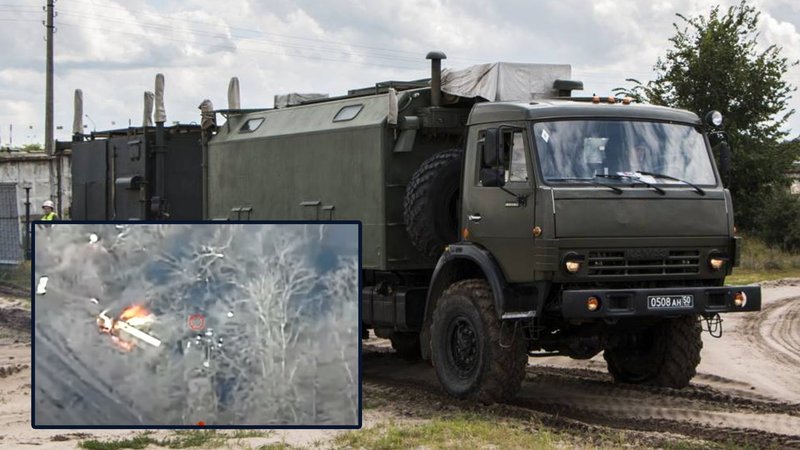Decisive Edge Newsletter | Digital Battlespace | May 2023
Newsletter Sponsors:
Battle of the planet? How counterspace electronic warfare systems are coming of age
The Secure World Foundation (SWF) published its Global Counterspace Capabilities report in May, and it’s one of the most comprehensive summaries of this important, emerging warfare domain.
Several near-peer rivals of the US are working hard to develop counterspace technologies. Russia for example re-energised her capabilities as the country embarked on its wider military modernisation, with these effects emerging in the wake of Russia’s performance during the 2008 war with Georgia.

The Russian armed forces have now invested in counterspace EW systems, targeting global navigation satellite systems (GNSS) such as GPS. Russia’s Pole-21 system jams position, navigation and timing signals transmitted earthwards by GNSS constellations and protects strategic targets from GPS-guided weapons.
The SWF report highlights incidences of civilian GPS jamming from 2016 onwards in and around Russian-occupied territory in Ukraine and also in Syria, affecting commercial maritime and air traffic. Russian forces also deploy EW systems like the R-330Zh Zhitel designed to attack communications satellite signals.
The report’s authors, Victoria Samson and Brian Weedon, say the uptake of EW in the counterspace battle is not surprising.
‘EW is attractive as a counterspace capability due to its inherent usability, compared to its kinetic counterpart. Jamming does not create debris [that can clutter the space environment and make it challenging to operate in for all]. It is harder to attribute than a kinetic weapon. It is perceived as being less escalatory, and there is a lower cost to entry, comparatively speaking,’ writes Samson.
‘EW is generally an easier and cheaper technology to get an effect than many of the other more destructive counterspace technologies,’ Weedon agrees.
Immediately following the second invasion of Ukraine on 24 February 2022, Russia performed a cyberattack against US provider Viasat’s KA-SAT network, but this was rapidly remedied through a software patch.
Russian cyberwarriors attempted similar hacking against SpaceX’s Starlink SATCOM terminals which have been deployed extensively in Ukraine. Once again, this was thwarted by using a software fix.

The Russian Army is thought to have struggled to jam the Ka-band frequencies used by KA-SAT and Starlink, which may have prompted the use of cyber effects instead to target these systems.
Kinetic anti-satellite (ASAT) capabilities under development in Russia include the 14TS033 Nudol direct assent ASAT (DA-ASAT) weapon capable of reaching targets in space. Likewise, Moscow is looking at orbital ASAT (O-ASAT) capabilities exemplified by the Burevestnik programme.

Above: A Russian Army R-330Zh Zhitel system seen here while travelling. This equipment is used by the Russian Army at the operational level to attack satellite communications. (Photo: Ukraine MoD)
The SWF report cautions that Russian engineers may also be developing laser-based weapons to dazzle reconnaissance satellites. One system, known as Peresvet, may have already been deployed to protect Moscow’s intercontinental ballistic missile force.
‘There’s not a lot of evidence… suggesting [Peresvet] has been operationally deployed, or at least not actively used in conflicts as of yet,” says Weedon. Nonetheless, there is intelligence that shows Russia and the People’s Republic of China (PRC) are ploughing significant resources into this kind of weapon.
The report warns that the PRC is also investing in kinetic ASAT weapons like the HQ-19 surface-to-air missile system. O-ASAT capabilities are also being researched, with several satellites being launched possibly to advance research in this area.
Chinese counterspace EW capabilities are more opaque than Russia’s. That we know more about Moscow’s capabilities in this regard is almost certainly the result of its involvement in the conflicts in Syria and Ukraine.
There is no evidence in the public domain of Chinese counterspace capabilities being used actively in military operations, the report adds. Nonetheless, it does say that GNSS jamming equipment may have been deployed on the Spratly Islands in the South China Sea, some of which the PRC occupies.
GNSS spoofing has been noted around the port of Shanghai on China’s east coast. Open-source details on Chinese counterspace directed energy weapons are scarce, although the country is probably working on such capabilities. Like Russia, China sees its counterspace capabilities as a key enabler for information warfare.

Above: A US warship patrols the South China Sea. Bejiing has reportedly begun deploying GNSS jamming capabilities in the region. (Photo: USN)
What of other rivals like Iran and the Democratic People’s Republic of Korea (DPRK)? The report assesses that Iranian and North Korean DA-ASAT and O-ASAT capabilities are all but non-existent. Nevertheless, both countries’ EW systems have shown they can disrupt civilian GNSS signals, although Iran’s ‘capacity to interfere with military signals is difficult to ascertain’.
To this end, the US government warned mariners in 2019 to exercise caution when navigating the Strait of Hormuz. Iran is thought to have placed GNSS jammers on Abu Musa island in the Persian Gulf near the strait’s entrance.
Similarly, the DPRK has shown herself capable of disrupting civilian signals from the US GPS constellation. Jamming has been experienced in the vicinity of the Demilitarised Zone, the de facto border between the two Koreas. Unlike military signals, civilian GPS transmissions are unencrypted, making them easier to jam.
The competencies of the DPRK and Iran are not surprising, says Samson: ‘Countries like Iran and North Korea may not have very strong space programmes but definitely have strong EW capabilities.’
Who is leading the counterspace race? ‘It's hard to say… Russia has a lot of legacy Cold War capabilities it is revitalising, but China has been doing its share of investment in counterspace capabilities,’ adds Samson.
‘Russia is far and away the leader in actively using counterspace capabilities in its military operations,’ notes Weedon.
The cosmos has arguably been a domain of warfare since the earliest days of Cold War space exploration by the US and the USSR. As reliance in the civilian and military worlds alike on satellites grows, so will the spectre of space warfare.
As investments by the DPRK, Iran, the PRC and Russia show, threats to satellites in space and the services they supply on Earth are unlikely to diminish. The Global Counterspace Capabilities report is a timely reminder of how seriously these threats should be taken.
Packing a punch – the US Army’s plans for next-generation EW for infantry
The US Army is contemplating replacement of its VROD (Versatile Radio Observation and Direction) and VMAX (VROD Modular Adaptive Transmit) backpack EW systems.
Both provide a communications intelligence (COMINT) collection capability for dismounted troops, and are believed to be capable of detecting and locating signals across a 300MHz to 3GHz waveband.

Above: The US Army’s TLS-BCT EW system programme sees the procurement of new backpacks to replace the current VMAX and VROD systems pictured here. (Photo: US Army)
VROD and VMAX may be able to gather COMINT at ranges of up to 6km. As such, they are most likely to be used at the tactical edge, and by dismounted special forces operators.
The army is in the midst of a major overhaul of its EW capabilities equipping the manoeuvre force. These efforts include procurement of Raytheon’s Electronic Warfare Planning and Management Tool (EWPMT). This provides EW command and control at the tactical to operational levels.
From a hardware perspective the army is planning new vehicular EW systems to be deployed at brigade level in the form of the Terrestrial Layer System – Brigade Combat Team (TLS–BCT).
Lockheed Martin is supplying an initial four TLS-BCT systems for $32.6 million, installed onboard M1133 medical evacuation variants of the General Dynamics M1126 Stryker armoured personnel carrier. Deployment of the first TLS-BCT systems could occur by early 2026, the US Army has said.
Plans were also afoot to procure a TLS variant to be deployed at operational level. Known as TLS-EAB (Echelon and Above) this latter initiative now appears in flux as the army contemplates a reorganisation of parts of the manoeuvre force into a divisional structure in preparation for future conflicts.

Above: The first four TLS-BCT systems will be mounted on board modified M1133 variants of the ubiquitous Stryker armoured vehicle. (Image: US Army)
That said, the TLS-BCT programme appears safe. Part of the acquisition, along with dedicated systems and carrier vehicles, includes procurement of a new backpack EW system.
The recently released US DoD budget request for FY2024 included requests of $65 million for development of the TLS-BCT, including its backpack component.
Demonstrations of the latter are expected by the end of this year. These are being built by Mastodon Design which is supplying an initial 52 systems with a unit price of circa $753,800.
The TLS-BCT/EAB capability also has tactical and operational cyberwarfare functions built into its mission system; it is therefore possible that such effects will also be included in the EW backpack.
The latter could also be one of the first new EW capabilities deployed, with a decision expected on an early fielding by mid-2024, the budget request notes.
The struggle against SWAP – miniaturised sensors are joining the fight
There is an understandable imperative to continually reduce the size, weight and power (SWAP) consumption of sensor technologies used by land forces.
Manoeuvre force troops and vehicles are both restricted in the SWAP consumption demands of the sensors that they can carry. Meanwhile, emerging multi-domain operations (MDO) doctrines create an imperative to deploy sensors across the land manoeuvre force and beyond.
MDO essentially sees every soldier, platform, weapon and capability as sensors which need connecting to one another, and outwards to other forces.

Above: Numerous ‘Future soldier’ efforts have touted the benefits of wearable sensors. (Image: US Army)
In May, MAG Aerospace and Boldend revealed they were working together to exploit SWAP-reduced sensor technology for several applications. However, it is in the land environment where Boldend sees significant applications for the miniaturised sensing approaches it has developed.
The company is working on small-sized devices to perform a range of functions, which could include everything from data collection to sensing, and command and control tasks.
This is a major challenge. As Jon Steinbach, Boldend’s CEO, told the author that squaring the need to reduce SWAP while ensuring no loss in capability presents a quandary. While the tactical and operational benefits of providing soldiers with body-worn sensors is clear, a balance must be struck: ‘The smaller you go, you lose some functionality, so it is a delicate balance.’
Another key driver is the need to keep technologies as easy to use as possible. There is little benefit in having a solder-worn system which is complex to operate, particularly in the heat of battle: ‘Our approach is to “cyber enable” your current warriors. We do this through methodologies in training and delivering easy-to-use devices that do not require expert-level operators.’
While the company would not be drawn on the technology readiness levels of its wares, Steinbach stressed that ‘we have devices ready today and we will continue to push development and challenge ourselves to change the face of cyber and increase effectiveness on the battlefield through scale’.
He continued that the company has delivered the ‘the first iteration of devices, and we are working directly with our customers to continue to evolve’. Steinbach added that Boldend was not able to disclose these customers’ identity.
Don't want to miss out on future Decisive Edge content? Make sure you are signed up to our email newsletters.












